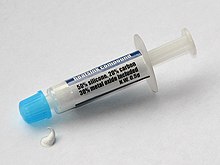Thermal paste





Thermal grease (also called CPU grease, heat paste, heat sink compound, heat sink paste, thermal compound, thermal gel, thermal interface material, or thermal paste) is a thermally conductive (but usually electrically insulating) compound, which is commonly used as an interface between heat sinks and heat sources (e.g., high-power semiconductor devices). The main role of thermal grease is to eliminate air gaps or spaces (which act as thermal insulator) from the interface area in order to maximize heat transfer. Thermal grease is an example of a thermal interface material.
As opposed to thermal adhesive, thermal grease does not add mechanical strength to the bond between heat source and heat sink. It will have to be coupled with a mechanical fixation mechanism such as screws, applying pressure between the two, spreading the thermal grease onto the heat source.
Composition
Thermal grease consists of a polymerizable liquid matrix and large volume fractions of electrically insulating, but thermally conductive filler. Typical matrix materials are epoxies, silicones, urethanes, and acrylates; solvent-based systems, hot-melt adhesives, and pressure-sensitive adhesive tapes are also available. Aluminum oxide, boron nitride, zinc oxide, and increasingly aluminum nitride are used as fillers for these types of adhesives. The filler loading can be as high as 70–80% by mass, and raises the thermal conductivity of the base matrix from 0.17–0.3 W/(m·K) (watts per meter-kelvin) up to about 2 W/(m·K).[1]
Silver thermal compounds may have a conductivity of 3 to 8 W/(m·K) or more, and consist of micronized silver particles suspended in a silicone/ceramic medium. However, metal-based thermal grease can be electrically conductive and capacitive; if some flows onto the circuits, it can cause malfunctioning and damage.
The most effective (and most expensive) pastes consist almost entirely of liquid metal, usually the alloy galinstan, and have thermal conductivities in excess of 13 W/(m·K). These are difficult to apply evenly and have the greatest risk of causing malfunction due to spillage. These pastes contain gallium, which is highly corrosive to aluminium and cannot be used on aluminium heat sinks. These are usually applied directly to the die after delidding a CPU.
Filler properties (at 300 K)
| Compound | Thermal conductivity in W/(m·K) |
Electrical resistivity in Ω·cm |
Thermal expansion coefficient in 10−6 K−1 |
Refe- rence |
|---|---|---|---|---|
| Diamond | 20‒2000 | 1016‒1020 | 1.18 | [2] |
| Silver | 418 | 18.9 | [3] | |
| Aluminum nitride | 140‒180 | > 1011 | 4.15 (par), 5.27 (ortho) | [4] |
| β-Boron nitride | 100 | > 1010 | 11.9 | [4] |
| Zinc oxide | 25.2 | [5] | ||
| Silicon Carbide | 120 | 4 |
See also
- Computer cooling
- Hot-melt adhesive
- Phase-change material
- Thermally conductive pad
- Thermal adhesive
- List of thermal conductivities
References
- ^ Werner Haller; et al. (2007), "Adhesives", Ullmann's Encyclopedia of Industrial Chemistry (7th ed.), Wiley, pp. 58–59.
- ^ Otto Vohler; et al. (2007), "Carbon", Ullmann's Encyclopedia of Industrial Chemistry (7th ed.), Wiley
- ^ Hermann Renner; et al. (2007), "Silver", Ullmann's Encyclopedia of Industrial Chemistry (7th ed.), Wiley, p. 7
- ^ a b Peter Ettmayer; Walter Lengauer (2007), "Nitrides", Ullmann's Encyclopedia of Industrial Chemistry (7th ed.), Wiley, p. 5
- ^ Hans G. Völz; et al. (2007), "Pigments, Inorganic", Ullmann's Encyclopedia of Industrial Chemistry (7th ed.), Wiley
External links
- Barros, Daniel (2006-01-12). "Thermal paste buying guide".
